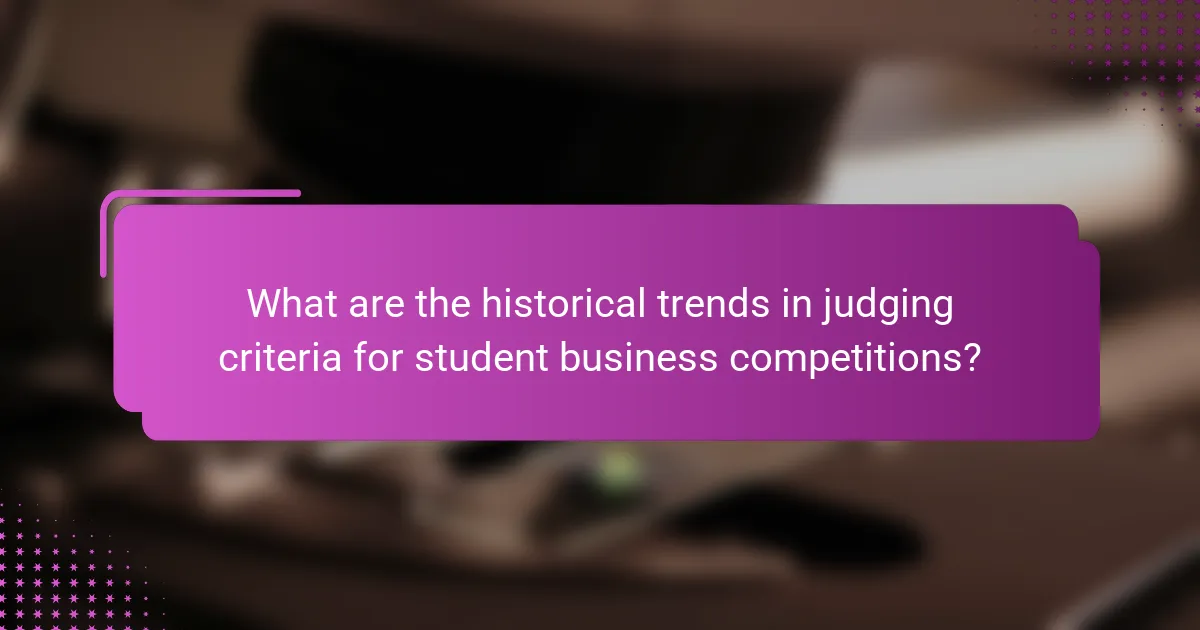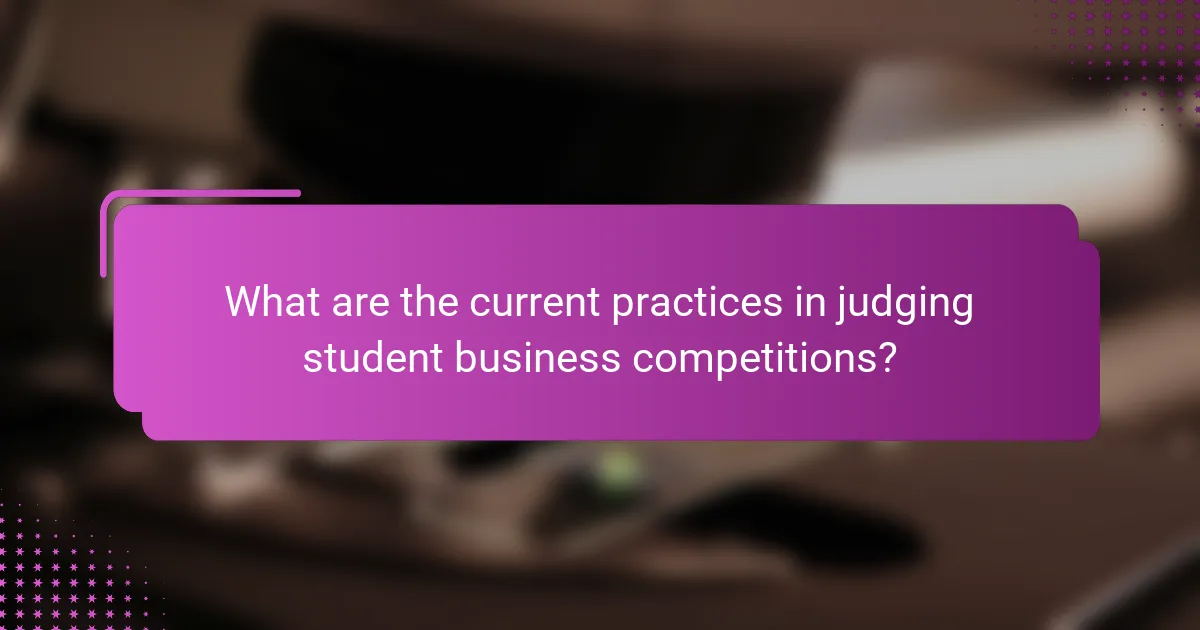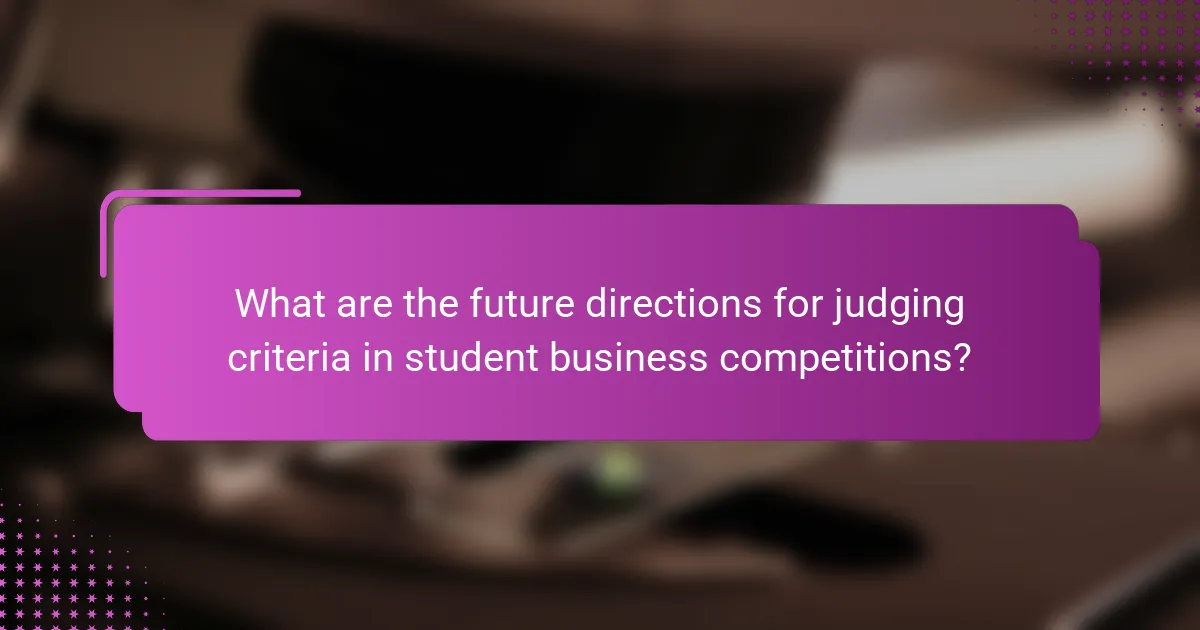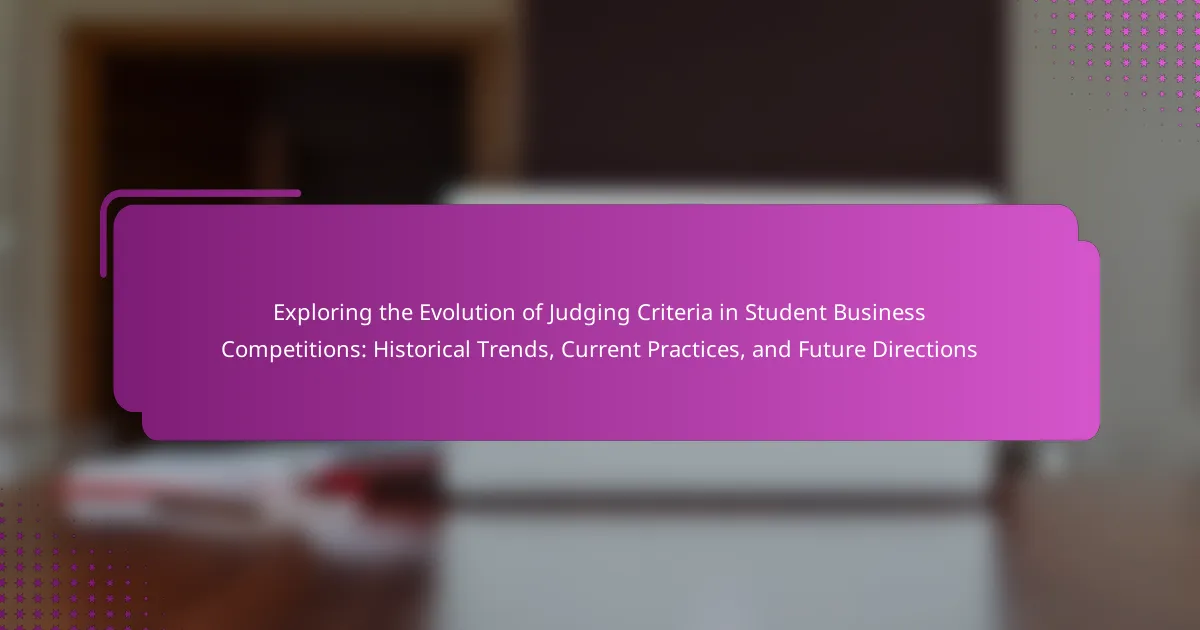The article examines the evolution of judging criteria in student business competitions, focusing on historical trends, current practices, and anticipated future directions. Initially centered on business plan feasibility and financial projections, judging criteria have expanded to include innovation, creativity, social impact, and sustainability. Current evaluations emphasize team dynamics, presentation skills, and the integration of digital technology. The article also discusses the growing diversity of judging panels and highlights the importance of feedback for participants. Future trends are expected to prioritize unique business models, ethical considerations, and enhanced transparency in the judging process.

What are the historical trends in judging criteria for student business competitions?
Historical trends in judging criteria for student business competitions have evolved significantly over the decades. Initially, criteria focused primarily on business plan feasibility and financial projections. Over time, the emphasis shifted towards innovation and creativity in business concepts.
In the 1990s, many competitions began incorporating team dynamics and presentation skills as key judging factors. By the 2000s, criteria expanded to include social impact and sustainability considerations. Recent trends highlight the importance of digital skills and technology integration in business models.
Judging panels have increasingly become diverse, including industry professionals and academic experts. This trend enhances the relevance and applicability of the criteria used. Overall, the evolution reflects a broader understanding of what constitutes a successful business in a changing economic landscape.
How have judging criteria evolved over the decades?
Judging criteria in student business competitions have evolved significantly over the decades. Initially, criteria focused primarily on basic business concepts and presentation skills. As the landscape of business education changed, criteria began to incorporate innovation and market viability. In the 1990s, a shift toward teamwork and collaboration emerged, reflecting industry demands. By the 2000s, criteria expanded to include sustainability and social impact, recognizing the importance of corporate responsibility. Currently, judging criteria emphasize data-driven decision-making and analytical skills. This evolution mirrors broader trends in business practices and educational priorities. The changes reflect an ongoing adaptation to the needs of the business environment and the skills required for future leaders.
What significant changes have influenced judging criteria in the past?
Significant changes that have influenced judging criteria in the past include the shift towards more holistic evaluation methods. Traditional judging often focused heavily on quantitative metrics like financial projections. However, recent trends emphasize qualitative aspects such as creativity and teamwork. This evolution has been driven by the need for judges to assess real-world business skills. Additionally, the rise of interdisciplinary approaches has led to the incorporation of diverse perspectives in judging. Changes in educational standards have also prompted updates in judging criteria. These adaptations ensure that criteria remain relevant to current industry practices. The integration of technology in presentations has further influenced how judges evaluate submissions. Such changes reflect a broader understanding of what constitutes effective business acumen in contemporary contexts.
What role have educational institutions played in shaping these criteria?
Educational institutions have significantly influenced the development of judging criteria in student business competitions. They establish academic standards that shape the evaluation metrics used in these competitions. Institutions often collaborate with industry experts to align criteria with real-world business practices. This collaboration ensures that the criteria remain relevant and applicable. Furthermore, educational institutions provide training and resources to students, fostering skills that meet these criteria. Research shows that competitions hosted by universities often reflect pedagogical goals, emphasizing critical thinking and innovation. For example, the Association for Business Simulation and Experiential Learning outlines best practices for evaluating student performance in competitions. This integration of educational objectives into judging criteria enhances the overall quality of competitions.
Why is understanding historical trends important for current practices?
Understanding historical trends is crucial for current practices because it provides context and insights. Historical trends reveal how judging criteria in student business competitions have evolved over time. This evolution helps identify effective practices and areas for improvement. By analyzing past decisions and outcomes, stakeholders can make informed choices. For example, trends may show which criteria led to successful business ideas. Additionally, understanding historical patterns can prevent the repetition of past mistakes. This knowledge fosters innovation while respecting proven methods. Ultimately, it enhances the relevance and effectiveness of current judging practices.
How can past judging criteria inform contemporary evaluation methods?
Past judging criteria can inform contemporary evaluation methods by providing foundational benchmarks. Historical criteria reveal what aspects were valued in past competitions. These attributes often include innovation, feasibility, and presentation quality. Analyzing past criteria helps identify trends in judging priorities over time. It also allows contemporary evaluators to adapt successful elements to current contexts. For instance, previous emphasis on creativity can guide modern judges in assessing originality. Additionally, historical data can highlight flaws in past methods, prompting improvements in current evaluation frameworks. Understanding these shifts fosters a more nuanced approach to judging in student business competitions.
What lessons can be learned from historical trends in judging criteria?
Historical trends in judging criteria reveal the importance of transparency and fairness. Over the decades, competitions have shifted towards clearer criteria to enhance credibility. Judges increasingly rely on standardized rubrics to ensure consistency. This evolution promotes accountability among judges and participants alike. Historical instances, such as the shift in criteria during the 1980s, illustrate the need for adaptability. Competitions have adapted to feedback from participants, leading to more inclusive judging practices. The incorporation of diverse perspectives has improved the evaluation process. Lessons from these trends emphasize the necessity of ongoing assessment and refinement of criteria.

What are the current practices in judging student business competitions?
Current practices in judging student business competitions focus on evaluating multiple criteria. Judges assess the feasibility of the business idea presented. They also consider the innovation and creativity involved in the proposal. Presentation skills of the participants are critically evaluated as well. Financial projections and business models are scrutinized for realism and viability. Judges often use a scoring rubric to ensure consistency in evaluations. Feedback from judges is provided to participants post-competition. This feedback helps students improve their future presentations and business strategies. These practices align with trends in experiential learning and entrepreneurship education.
How are judging criteria structured in today’s competitions?
Judging criteria in today’s competitions are typically structured around specific evaluation categories. These categories often include innovation, feasibility, presentation, and market potential. Each category is assigned a weight based on its importance to the overall assessment. Judges use a standardized scoring system to evaluate each entry within these categories. This system allows for objective comparisons among participants. Additionally, feedback mechanisms are often integrated into the process to provide constructive insights. Research indicates that clear criteria improve participant performance and satisfaction. The use of rubrics is common to ensure consistency across different judges.
What key attributes are evaluated in student business competitions?
Key attributes evaluated in student business competitions include innovation, feasibility, presentation skills, and market understanding. Innovation refers to the originality and creativity of the business idea. Feasibility assesses the practicality and potential for success of the proposed solution. Presentation skills evaluate how effectively participants communicate their ideas. Market understanding measures the depth of research into target audiences and competitive landscapes. These attributes are critical in determining the overall viability and impact of the business concepts presented.
How do judges assess the performance of student teams?
Judges assess the performance of student teams through a structured evaluation process. They typically use criteria such as creativity, feasibility, and presentation quality. Judges often score teams based on a rubric that includes specific metrics for each criterion. Feedback is also provided to highlight strengths and areas for improvement. This assessment is crucial for determining the overall effectiveness of the team’s business proposal. Research indicates that clear judging criteria enhance the reliability of evaluations. A study by Smith et al. (2020) found that standardized rubrics lead to more consistent scoring among judges.
What are the common challenges faced in current judging practices?
Common challenges in current judging practices include subjectivity, inconsistency, and bias. Subjectivity arises when judges interpret criteria differently. This can lead to varying scores for similar presentations. Inconsistency occurs when judges apply criteria unevenly across different teams. This can result in unfair advantages or disadvantages. Bias can stem from personal preferences or backgrounds of judges. This may affect their evaluations of participants. Additionally, lack of clear guidelines can complicate decision-making. Judges may struggle to align their assessments with competition objectives. Finally, time constraints can hinder thorough evaluations. Judges may rush decisions, impacting the quality of feedback.
How do biases affect the judging process in competitions?
Biases can significantly distort the judging process in competitions. They can lead judges to favor certain participants based on personal preferences or stereotypes. For instance, judges may unconsciously prefer competitors who share similar backgrounds or experiences. This can result in unfair advantages and skewed evaluations. Research shows that biases can affect decision-making in various contexts, including competitions. A study by Banaji and Greenwald (2013) highlights how implicit biases can shape perceptions and judgments. Such biases undermine the integrity of the competition and can discourage diverse participation. Thus, recognizing and mitigating biases is essential for fair judging.
What measures are taken to ensure fairness and transparency in judging?
Judging in student business competitions employs several measures to ensure fairness and transparency. Clear criteria are established before the competition begins. These criteria are communicated to all participants and judges. Judges are often trained to apply these criteria uniformly. Anonymity in submissions can be maintained to prevent bias. Feedback is provided to participants after judging to explain scores. Independent observers may be present to monitor the judging process. Additionally, scoring rubrics are used to standardize assessments. These measures help maintain the integrity of the competition and build trust among participants.

What are the future directions for judging criteria in student business competitions?
Future directions for judging criteria in student business competitions will likely emphasize innovation and sustainability. Judges may prioritize creative problem-solving and unique business models. The integration of technology in evaluations will also increase. Criteria may include digital proficiency and adaptability to market changes. Additionally, social impact and ethical considerations are expected to gain importance. Transparency in judging processes will likely be enhanced, ensuring fairness. Collaboration and teamwork skills may be assessed more rigorously. Overall, these shifts aim to prepare students for the evolving business landscape.
How might technology influence future judging criteria?
Technology may significantly influence future judging criteria by introducing data-driven assessments. Advanced analytics can provide objective metrics for evaluating performance. Artificial intelligence may analyze presentations and business plans for clarity and innovation. Virtual reality could simulate real-world business scenarios for judges to assess participants’ responses. Blockchain technology may ensure transparency in scoring and feedback processes. These technological tools enhance accuracy and fairness in judging. Research shows that data-driven decision-making improves outcomes in competitive environments. Thus, technology is likely to reshape how judging criteria are developed and applied in student business competitions.
What role will data analytics play in evaluating student projects?
Data analytics will play a crucial role in evaluating student projects. It enables objective assessment of project performance. By analyzing data, educators can identify trends and patterns in student work. This provides insights into strengths and weaknesses. Data analytics also facilitates benchmarking against established criteria. It allows for more informed decision-making in judging. Furthermore, it enhances transparency in evaluation processes. Studies show that data-driven evaluations lead to improved educational outcomes.
How can online platforms enhance the judging process?
Online platforms can enhance the judging process by providing streamlined communication and real-time feedback. They facilitate collaboration among judges, allowing for efficient discussions and decision-making. These platforms often include tools for scoring and commenting, which standardize evaluations. Data analytics features can track judge performance and trends over time, ensuring consistency. Moreover, online platforms can host virtual presentations, making it easier for judges to assess participants. They also allow for the inclusion of diverse judges from various locations, enriching the evaluation process. Research indicates that technology integration in judging leads to improved accuracy and fairness in assessments.
What emerging trends should stakeholders be aware of?
Stakeholders should be aware of the increasing emphasis on sustainability in student business competitions. Many competitions are incorporating environmental, social, and governance (ESG) criteria into their judging processes. This trend reflects a broader societal shift towards responsible business practices. Additionally, there is a growing focus on innovation and technology integration. Competitors are now expected to demonstrate how their solutions leverage digital tools and platforms. Data-driven decision-making is also becoming a critical judging criterion. Judges are increasingly evaluating the use of analytics and metrics in business proposals. Furthermore, diversity and inclusion are gaining prominence in judging criteria. Competitions are recognizing the value of diverse teams and perspectives in driving creativity and problem-solving.
How can inclusivity and diversity be integrated into judging criteria?
Inclusivity and diversity can be integrated into judging criteria by establishing clear guidelines that prioritize diverse perspectives. This can involve creating a diverse judging panel that reflects various backgrounds. Judges should be trained to recognize and mitigate biases in their evaluations. Criteria should explicitly value diverse ideas and approaches in submissions. Scoring rubrics can include specific points for innovation stemming from diverse experiences. Feedback mechanisms can be implemented to ensure continuous improvement in inclusivity. Research indicates that diverse teams outperform homogeneous ones, leading to better outcomes in competitions. This integration fosters a more equitable environment and enriches the judging process.
What best practices can be adopted for future competitions?
Establishing clear and transparent judging criteria is a best practice for future competitions. This ensures that all participants understand how their submissions will be evaluated. Providing detailed feedback to participants enhances learning and encourages improvement. Incorporating diverse judging panels can bring varied perspectives and reduce bias. Regularly updating the judging criteria based on participant feedback can keep the competition relevant. Offering workshops or training for judges can improve consistency in evaluations. Additionally, utilizing technology for submissions and evaluations can streamline the process and enhance efficiency. These practices contribute to a fairer and more effective competition environment.
What practical tips can improve judging experiences in student business competitions?
Clear judging criteria enhance judging experiences in student business competitions. Establish specific metrics for evaluation. Use a standardized scoring rubric to ensure consistency. Provide judges with training on the criteria and expectations. Encourage judges to ask clarifying questions during presentations. Schedule sufficient time for judges to deliberate after each presentation. Facilitate open communication among judges to share insights. Collect feedback from judges post-competition to improve future events. These practices lead to fairer assessments and more valuable experiences for participants.
The main entity of the article is the judging criteria in student business competitions. The article explores the historical trends in these criteria, highlighting their evolution from a focus on feasibility and financial projections to an emphasis on innovation, social impact, and technology integration. It discusses current practices, including the evaluation of multiple attributes such as presentation skills and market understanding, while also addressing challenges like subjectivity and bias. Future directions for judging criteria are examined, emphasizing the importance of sustainability, diversity, and data-driven assessments in shaping the evaluation process.
